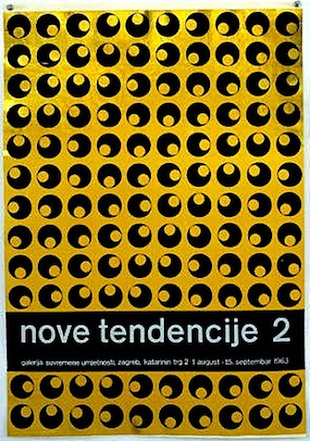Design
Ivan Picelj: Painter, Sculptor, Graphic Designer
An advocate of geometric abstraction and new modes of visual expression during his lifetime, Ivan Picelj is one of the major figures in the development of Croatian modern art. Born in 1924 in Okučani, Picelj attended the Academy of Fine Arts in Zagreb from 1943 to 1946. He then co-founded the modernist group Exat 51 as well as the Studio of Industrial Design, and was also a formative member of the international New Tendencies movement.
Before his death in 2011, Picelj sold almost his entire graphic design collection to the Museum of Arts and Crafts (MUO) in Zagreb, including some 400 to 500 posters, catalogues, and visual identities for different companies. MUO’s curator of graphic design, Koraljka Vlajo, is currently selecting works from Picelj’s oeuvre for an exhibition of recent acquisitions in April 2013.
“He’s perhaps one of the most important figures in Croatian graphic design,” she explains, speaking about his historical impact. “For example, he’s the one that we’re always mentioning when talking about typography in Croatia because he introduced Helvetica to Croatia. He’s the one who started using it most prominently. “He was also working with Exat 51, one of the most important art, design, and architecture groups immediately after World War II in Croatia,” she continues. “They’re the ones who were trying to promote abstract art, [as a reaction] against social realism . . . So he was one of the most important figures in the promotion of abstract art.”
Much of Picelj’s mid-century work features striking geometric abstractions in a limited palette, often shades of blue and gray, arranged to stimulate the eye and create compositional movement. His graphic design also reveals an interest in visual perception. For example, his poster for the second exhibition of New Tendencies, held in 1963, features one repeating shape: an offset circle within a circle. Each circle is slightly rotated, creating an illusion of movement.
“When you look at his posters for other exhibitions at this time, for example Mutić and Vidović, you see that it’s the same repeating systems,” says Vlajo, discussing Picelj’s engagement with New Tendencies, which focused on new media, computer art, and perceptive processes. The movement would become known as a catalyst for the international Op Art trend of the 1960s.
Like most of Croatia’s most prominent modern artists, Picelj was engaged in both fine art and design throughout his life. “I think this was typical for artists of his generation – basically all of the ones who were doing design before there was a design school,” explains Vlajo, noting that the School of Design was not founded until 1989.
“All of the very important designers in Croatia were actually not designers by training. First, they were painters. Very often, design was considered a way to make some money while waiting for a painting to sell.”
Vlajo estimates that around 90 percent of Picelj’s design work was for cultural institutions. “He was working with the biggest museums and galleries in Croatia, so at one time or another he probably did a poster for everybody.” Picelj’s work is internationally recognized and included in a number of prestigious museum collections, including the Museum of Modern Art in New York, Victoria & Albert Museum in London and the Centre Georges Pompidou in Paris. He exhibited many times in Paris, and most recently, he was selected as one of the artists representative of Croatian culture in the French festival Croatie, la voici, with a solo exhibition at Galerie Denise René.
His legacy, however, is most pronounced in Croatia, where his work continues to inform contemporary designers. “I think that every young Croatian designer discovers Picelj at one point during university,” says Vlajo. “And in a way, I’m certain that he leaves his mark.”
Written by: Elaine Ritchel (@elaineritchel)
Image source: www.stari.gradst.hr, www.moma.org, www.zkm.de










